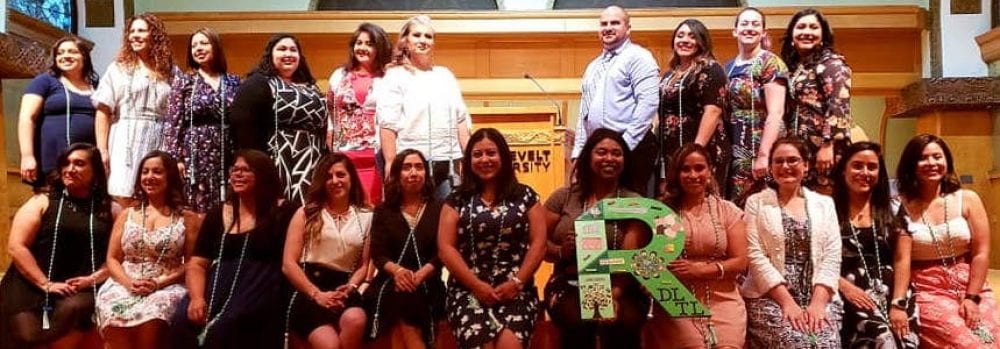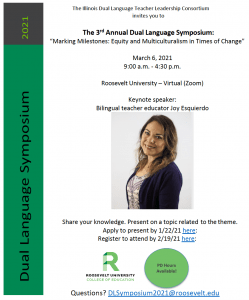by Aaron and Rebekah Dembowski
There is no denying that our society is changing. We are living in a more globalized world with an increasing amount of cultural connections occurring more than ever before. We as a nation are experiencing dynamic shifts in our own American culture and a need for greater cohesiveness and unity in dealing with these increased cultural relations and interactions is paramount for our collective success. Similarly, the field of bilingual education is also experiencing dynamic shifts in the way we instruct, assess, and advocate not only for our emergent bilingual students, but also the very programs in which we teach.
Having experienced a variety of bilingual program models throughout our careers, we have gone from educating emergent bilingual students with the end goal being English acquisition (TBE, Sheltered English, etc.) towards more equitable and self-affirming program models (Dual Language) that ultimately focus on preparing students to become bilingual, biliterate, and bicultural. We are extremely proud in our role as dual language educators, advocates and leaders. In this article, we will outline our district’s efforts toward more equitable assessment practices for emergent bilingual students and detail our success, challenges and everything in between.
Setting the Stage
LaGrange District 102 has demonstrated a strong commitment to diversity, equity, and inclusive practices for in each of its six schools. In an attempt to raise student achievement and as a result of numerous strategic visioning and planning sessions, the Dual Language program at Congress Park Elementary was born. Since its inception in 2017, the dual language program has evolved and adapted to the shifts in bilingual education with much consideration and effort made to ensure that teachers are equipped with the necessary skills and resources to be successful. By providing continual teacher professional development that utilizes emerging research on dual language best practices, District 102 demonstrates its willingness to be at the forefront of new and upcoming trends in dual language education.
A Vision for the Future
The co-existence of two or more languages contributes to a uniquely endowed human being whose experiences and knowledge can never be measured or understood as independently constrained by each language separately.” (Escamilla et al., 2010, pp.24-25)
As increasing populations of simultaneous bilingual students (ones who are exposed to two languages from a young age) enter classrooms across the nation, many districts oftentimes struggle to authentically and accurately assess not only a student’s language capacity in both languages, but also the student’s content knowledge. In District 102, we have begun implementing a variety of assessment modifications that have greatly impacted our emergent bilingual population and their trajectory toward biliteracy.
Highlighting the work and research of Cecilia M. Espinosa and Laura Ascenzi-Moreno in their seminal work titled Rooted in Strength, our district focused on making the use of multilingual, strength-based responsive adaptations in literacy instruction a priority for our emergent bilingual student population. (Espinosa & Ascenzi-Moreno, 2021)
What are Multilingual, Strength-Based Responsive Adaptations?
Espinosa & Ascenzi-Moreno (2021) define multilingual, strength-based responsive adaptations as “flexible ways of adapting assessments so that students’ multilingual resources are taken into account during the process—so that you can build accurate understandings of emergent bilingual readers” (p. 116). This modification to traditional assessment practices is predicated on the fact that emergent bilinguals utilize both linguistic repertoires to make meaning. This phenomenon is commonly referred to as translanguaging. Through this translanguaging lens, teachers can gain better insight into the unique language skills an emergent bilingual student already possesses, and leverage those skills to further scaffold and support students in their areas of need.
Putting Multilingual, Strength-Based Responsive Adaptations into Practice
“When a bilingual individual confronts a monolingual test… both the test taker and the test are asked to do something they cannot. The bilingual test taker cannot perform like a monolingual. The monolingual test cannot “measure” in the other language.” Valdes & Figueroa (1994)
Like many districts across the nation, District 102 utilizes the Fountas and Pinnell Benchmark Assessment System (BAS) in both English and Spanish in order to monitor student reading achievement in both languages. Based on empirical research, the BAS “assesses the five elements of reading that are described by the National Reading Panel—phonological awareness, phonics, vocabulary, fluency, and comprehension” in addition to addressing “issues of student motivation and interest in reading” (Fountas and Pinnell Benchmark Assessment System (1 and 2): The Research Base, 2008). Through precise administration, the BAS is intended to capture pertinent information on students’ reading behaviors in order for teachers to further support student learning.
Espinosa & Ascenzi-Moreno (2021) outline and categorize the multilingual, strength-based responsive adaptations into three categories as they correlate to the administration of the running record protocol similar to that which is featured in the Fountas and Pinnell BAS. They include:
- Introducing a text
- Listening and Documentation of Student Reading
- Retelling and Answering Comprehension Questions
When introducing a text used for the running record, it is important to leverage both linguistic repertoires wherever and whenever possible in order to increase an emergent bilingual student’s reading capacity. In addition, by reintroducing key vocabulary pertinent to the passage, pointing out culturally-specific key words and phrases, and helping construct background knowledge through the use of visual supports, teachers provide emergent bilingual readers more equitable access to the text.
During the listening and documentation of student reading phase of the running record, it is suggested that assessment administrators delineate if and when student miscues are related to language rather than reading-related. Since emergent bilingual students are learning more than one language, their miscues indicate their knowledge across both languages. (Espinosa & Ascenzi-Moreno, 2021) If it is determined that the miscue is a result of language, it should not be counted as an error. Additionally, when an emergent bilingual student is reading, it is encouraged that the assessment administrator provides targeted vocabulary support in the student’s home language if it is requested. In these specific cases, a quick explanation or TPR demonstration of the meaning would suffice.
Lastly, with regard to the retelling and answering of comprehension questions section of the reading assessment, it is strongly encouraged to invite emerging bilingual students to utilize their full linguistic repertoire. Since the main goal of reading is to uncover meaning, by limiting a student’s language resource would defeat the purpose of the assessment itself and therefore should be discouraged for bilingual students. Also, rephrasing or reframing comprehension questions for emergent bilingual students ensures that they are more accessible and comprehensible.
Challenges of Implementation
Making changes to any familiar assessment practice can be a challenging undertaking for a variety of reasons. Attempting to implement these more equitable assessment practices will take a concerted effort on the behalf of all teachers. In addition, it will take time and effort for all teachers to become more familiar with the languages of the students within their classroom. Lastly, it will require bilingual teachers to coach monolingual teachers on what types of common language miscues an emergent bilingual student may exhibit.
Final Thoughts
“If schools are to evolve, the traditional organizational structure of schools must be transformed to reflect a new set of assumptions that epitomizes social justice.” Bustamante, et al. (2009)
To provide a clearer and more accurate picture of an emergent bilingual’s academic capacity, it is imperative that we adapt our assessment practices to allow for students to draw from all of their linguistic resources. We owe this to our students.
References:
Escamilla, K., Ruiz-Figueroa, O.A., Hopewell, S., Butvilofsky, S., Sparrow, W. (May 2010).
Transitions to Biliteracy: Literacy Squared. Literacy Squared.
http://literacysquared.org/ABOUT%20Page/Lit2%20Technical%20
Manual%20Phase%20I_2004_2009.pdf
Espinosa, Cecilia; Ascenzi-Moreno, Laura. Rooted in Strength: Using Translanguaging to Grow
Multilingual Readers and Writer. Scholastic.
Fountas and Pinnell. (2008). Fountas and Pinnell Benchmark Assessment
System (1 and 2): The Research Base. Heinemann.
https://www.fountasandpinnell.com/shared/resources/FP_BAS_
Research_The-Research-Base.pdf
Ruíz-Figueroa, O. (2015). Moving Assessment Toward Biliteracy [PowerPoint
slides]. Literacy Squared https://www.teachingforbiliteracy.com/wp-
content/uploads/2014/09/WIABE-Ru%C3%ADz-Figueroa-Moving-
Assessment-toward-Biliteracy-.pdf
About the Authors:
Aaron and Rebekah Dembowski are both Dual Language educators at Congress Park Elementary in Brookfield, Illinois. Together, they each bring nearly a decade of experience teaching in and advocating for bilingual and dual language education. As recent graduates of Roosevelt University’s Dual Language Teacher Leadership Master’s Program, they share a passion for promoting bilingualism, biliteracy and multiculturalism all through a lens of social justice.


